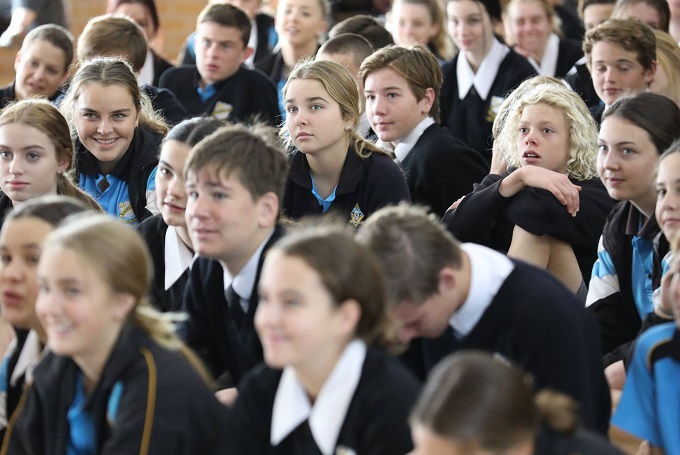Balancing screen time in schools & how theatre can help

Excessive screen time is emerging as a major concern for parents and teachers.
Children are learning to use digital devices from a young age and primary school students regularly use technology for entertainment and to socialise with friends. The latest Child Health Poll found that one-third of Australian pre-schoolers, two-thirds of primary school children and almost all teenagers own their own tablet or smart phone.

The Office of the eSafety Commissioner warns excessive screen time can contribute to sleep difficulties, obesity and poor school performance. A 2018 study found that any screen time beyond one hour per day was associated with lower psychological wellbeing in children and teens, including poorer self-control, curiosity, emotional stability, and poorer ability to complete tasks, manage distractions and make friends.
It has been suggested that screen time stunts imaginative play by saturating the senses with a constant stream of entertainment. Excessive screen time can also have implications for eye health, posture and sleep.
Digital health expert Dr Kristy Goodwin says displacement effects are one of the biggest issues – the more time kids spend on screens, the less time they are spending outdoors in sunlight, being physically active and developing balance, coordination and social skills.
How much time should kids
spend on devices?
The Australian Government’s Physical Activity And Sedentary Behaviour Guidelines recommend no more than two hours of leisure screen time per day for 5-to-17-year-olds. Dr Anthea Rhodes, paediatrician at the Royal Children’s Hospital, recommends keeping screens out of the bedroom and says it is best to have no screens one hour before bed.

While most parents try hard to limit their children’s screen time, it is becoming an increasing struggle. Many parents are left feeling ineffective and frustrated. Some experts believe the current guidelines are unrealistic and should be updated to be more applicable to our screen-saturated world.
It is also important to note that the current recommendations do not include time spent on devices at school and doing homework.
Margaret Kristin Murga from Murdoch University notes that most students are already exceeding the recommended screen time for leisure and believes we need guidelines that account for the hours spent using devices for schoolwork.
So what about screen time
in the classroom?
There are differing opinions about how devices should be used in education.
An SBS Insight program revealed that many Australian schools are embracing technology in the classroom and bring your own device (BYOD) policies are common practice.
Many educators believe that when it is well integrated into the learning environment, technology provides opportunities for more critical, curious and self-directed learning. When used appropriately, technology can make learning more engaging, interactive and efficient. It can prepare students for a rapidly changing world and an uncertain future.
Others, however, have observed a reduction in students’ ability to focus when there are devices in the room. They are struggling to keep students on task and compete with the distractions available on tablets and laptops. Monitoring of internet use is an ongoing challenge, with many students using hotspots to access blocked websites. Most teachers would agree with the need for restrictions on smartphone use, however policies differ greatly between schools.
While some students are able to self-moderate their technology use, this is a big ask for most, especially primary school students.
These issues are likely to place greater pressure on teachers and the student-teacher relationship.
The importance of balancing
screen time at school
In addition to clear limits and guidance, students need balance when it comes to technology use.
In fact, students often appreciate the value of screen-free learning time.
Whatever your school’s approach to technology, students still need to learn through a range of media and methods, using all of their senses.
They need to learn how to read from a book, write and draw with their hands, move their bodies in different ways, understand social cues and interact with nature. They need to learn how to focus on a single task, even when the task is boring. And they need to learn how to tune in to their thoughts, emotions and physical sensations.
Creative activities like music, dance, visual arts and drama can give students a variety of hands-on learning experiences. They require students to use different parts of the brain and expose them to the richness of human experience.
Breaking up screen time
with theatre in education
Theatre in education can be employed by teachers to enhance their existing student wellbeing programs and give students a break from screens.
Theatre companies provide the opportunity for students to explore issues like (cyber)bullying, cyber safety, screen time, mental health, resilience and respectful relationships while also engaging with a narrative.
There is evidence that students may learn more from a live performance than they do from a movie with the same themes. Theatre gives them the chance to connect with the actors in front of them and requires them to focus on one thing for an extended period. Social perspective taking, tolerance and a willingness to accept different opinions may all be enhanced through the experience of live theatre.
Live theatre may also inspire students to participate in drama and performance, which promotes a host of positive outcomes including creativity, self-esteem and emotional wellbeing.
The issue of screen time is at the forefront of the minds of parents, teachers, scientists and policy makers. As the digital world evolves, so does our understanding of how technology is impacting on children. Now, more than ever, we need to ensure students have access to a wide range of learning opportunities.







